FLORA AND FAUNA OF GALAPAGOS: THE LAND IGUANA

Maria s.
Maria s.
An incredible number of diverse animals and plants can call the Galapagos Islands home. Among others, the Ecuadorian islands are home to Galapagos giant tortoises and other numerous species of iguanas. The marine iguana, which we already introduced to you, belongs to one of these iguana species. Land iguanas can also be found on the Galapagos Islands and differ from marine iguanas both in color and feeding habits. In the following blog article, we take you on a journey into the world of Galapagos land iguanas.
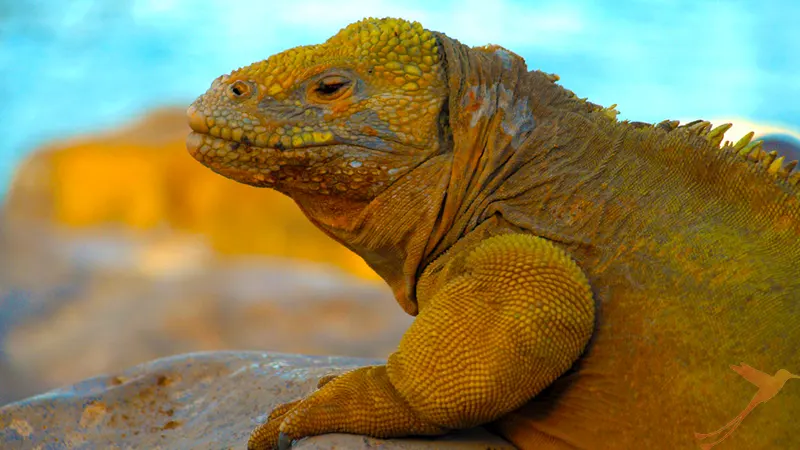
The land iguanas are often yellow and orange, to gold in color, and are marked with spots and skin folds. The color of their scale-like skin ensures their survival, because in the sand, on stones or on light-colored ground, they are more difficult for enemies to see, which protects them.
Another important feature is their dorsal spines, which extend from the head over the back to the tail, becoming smaller and smaller. The pink tongue is also a distinctive characteristic of the Galapagos land iguanas.
In addition, the iguanas are thought to have a mysterious appearance due to their mouthparts, which are reminiscent of the Mona Lisa’s famous ambiguous smile.
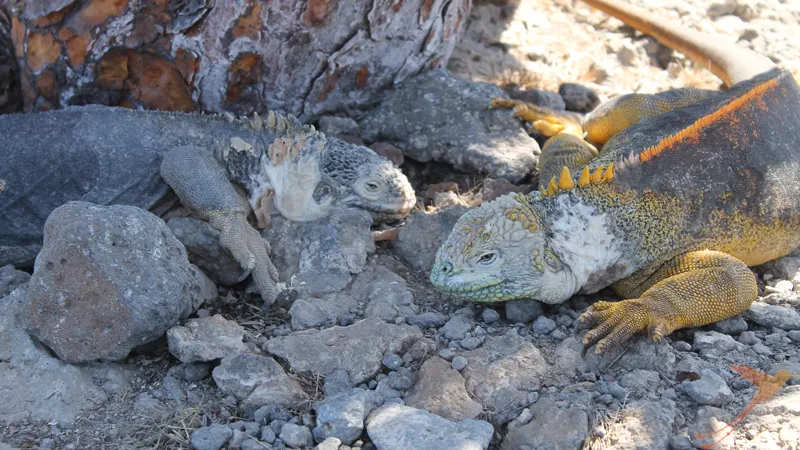
A special behavioral feature is that the animals are often seen with finches on their backs. The reason for this symbiosis is that the birds feed on the ticks and parasites on the iguanas’ bodies that infest the land iguanas. In return, the finches clean the lizards of small animals – so it’s a win-win situation for both species. Since land iguanas are not shy animals, it is also possible for human beings to approach them at short distances.
In addition, the land iguanas can grow more than 90 cm long, weighing about 8 kg. The maximum length is about 125 cm. Their tail is used for dropping to distract predators in dangerous situations. In total, the animals live about 50-60 years.
If you want to read more about the fauna and flora of the Galapagos Islands visit our blog.
HABITAT, DIET AND REPRODUCTION
Galápagos land iguanas prefer dry areas of the archipelago, living mainly on the islands of Baltra, Fernandina, Isabela, Seymour Norte, Santa Cruz and Plaza Sur. In total there are three different species, which differ from each other in color. Among others there are two yellow-brown iguana species and one that is slightly colored pink.
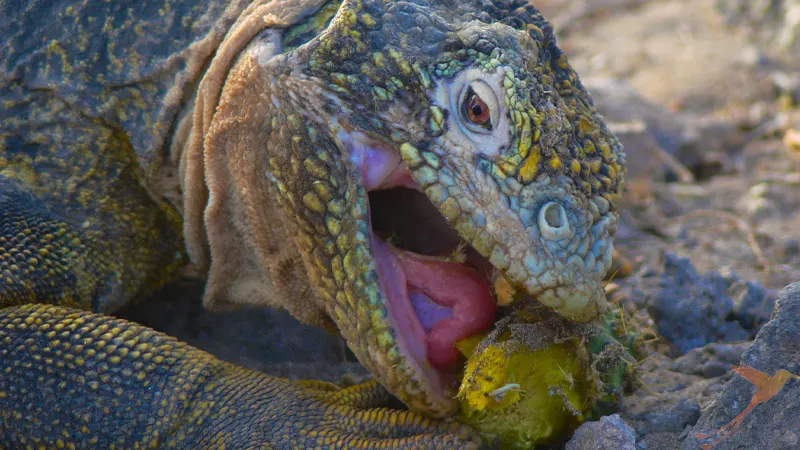
Especially, in the morning after sunrise they can be seen frequently. Towards noon they retreat into the shade of cacti because the sun’s rays are too strong for the animals, which are warm to the touch. In their shady places they can then lower their body temperature and cool down. Like marine iguanas, land iguanas are herbivores. Their diet consists mainly of cactus fruits and prickly pears. Since the spines prevent them from climbing up and harvesting the fruits, they wait for them to fall naturally from the plant.
If you have visited or plan to visit the Galapagos Islands, you may notice that many land iguanas perch on rocks. On the one hand, this can be because the animals want to sunbathe and warm up there. On the other hand, marking the territory may be the cause. If male iguanas want to reserve an area, they do so by sitting on a rock that is located in that particular area.
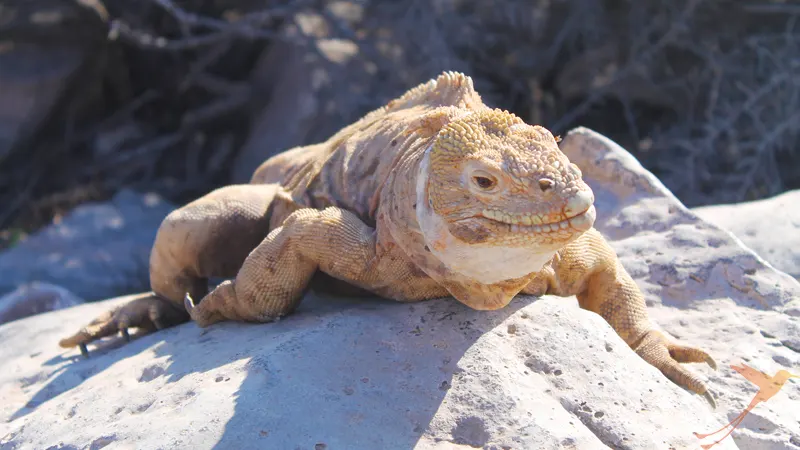
After mating, females lay up to 25 eggs, which are covered with a soft, leathery shell. The eggs are hidden in damp sand, under foliage or in holes in the ground. It is not uncommon for them to walk up to 15 km to find a suitable nesting site. The eggs are hatched with the help of the sun’s and the earth’s heat. After about three to four months the young hatch.
ENDANGERMENT
Unfortunately, land iguanas also belong to the endangered species. One reason is that they can be found in only one place on earth. The main threat to these animals are introduced animals such as goats, dogs and cats, which eat the iguana eggs and destroy nests. Juveniles in particular are eaten by hawks, cats, dogs and goats, but land iguanas as young as four years old are also preyed upon by cats. By 2019, for example, all the specimens on the island Santiago were extinct, and only a successful reintroduction project could save them.
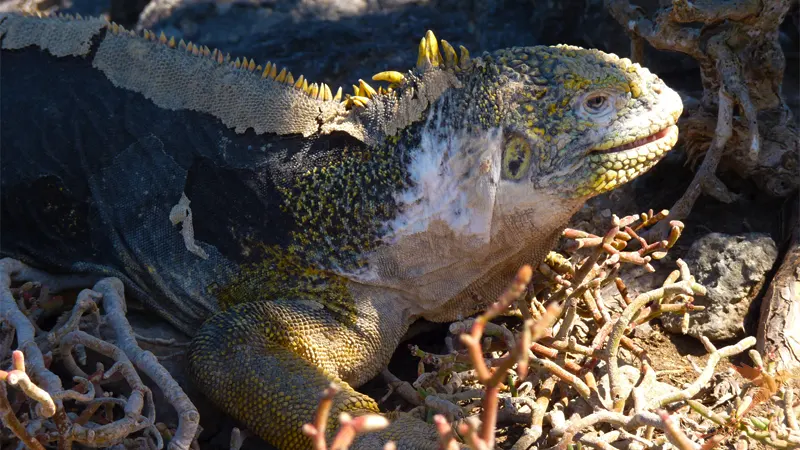
If you would like to visit this fragile nature and discover the various species of iguanas, you are welcome to browse our website. We offer different trips, among others indiviudal trips, but also group trips to the islands. In consensus with the conservation of nature, sustainability, ecological and safe travel is also our top priority. This way we can guarantee you an unforgettable vacation and at the same time protect our earth in the best possible way.
visit our other channels
Recent Posts
- From Manglaralto to Pacoche and surroundings April 18, 2024
- Excursions within the rainforest region of Ecuador April 5, 2024
- Ecuador in a state of emergency?! My personal experience March 22, 2024
- The 10 most beautiful lakes and lagoons in Ecuador – Part 2 March 12, 2024
- The 10 most beautiful lakes and lagoons in Ecuador – Part 1 February 23, 2024